Sales and Marketing Alignment: Help Your Sales Team Adopt Inbound

Times have changed. As technology continues to grow and make it easier for consumers to access information, salespeople no longer control the flow of information in the sales funnel. In fact, the typical B2B buyer is already through 70% of the buying process before they ever reach out to sales. This makes it more important than ever to ensure sales and marketing alignment within your business.
How do you grab the attention of a buyer who doesn’t want to talk to your sales team?
Inbound marketing.
Inbound marketing affects your funnel top to bottom, from generating quality leads to increasing your chance of closing a deal by 67%. Inbound marketing can have a huge impact on your business, and inbound tactics should form an integral part of every digital strategy in 2019.
Create Sales and Marketing Alignment: Convince Your Sales Team to Adopt Inbound
The challenge that many businesses face is getting their sales team to adapt to inbound. Salespeople are habitual individuals, and would rather stick to what has worked for them in the past than to experiment with innovative tactics. According to Dan Tyre of HubSpot, 57% of salespeople like doing things the way they’ve always done, no matter what. Still, aligning your sales and marketing departments—and getting them both excited about inbound—is a significant opportunity to improve your business performance.
So how do you overcome this hurdle? Here are our top tips for getting your sales team to embrace inbound.
#1. Offer Them Help, Not Advice
No one likes to be told what to do, especially when they’ve been doing their job the same way for decades. If you approach your sales team with unsolicited advice, they may feel like you’re questioning their performance and telling them how to do their job. Instead, do some research and find out how inbound marketing can help your sales team.
The first step is to gather data on your company quotas. A sales quota refers to a time-bound goal set by your sales team and is often attached to a specific period (daily, monthly, or yearly). Here are the four main types of sales quotas your sales department like lly has that you should know about:
- Revenue Quotas: Revenue quotas are measured based on company profits. One good question to ask your sales team is how many units or subscriptions they’re expected to sell within a given period.
- Activity quotas: This quota is based on a salesperson achieving a quantifiable activity—for example, how many clients does your sales team have to land in a given period?
- Volume quotas: This refers to the number of units sold or total revenue generated for a specific period. Volume quotas take into account the individual products, branch offices or lines.
- Combination quotas: A combination quota is when both sales volume and rep activity are combined. For example, this might include the percentage of reduction in sales expenses or the number of orders per customer.
The reason why many salespersons come across as grumpy is because they have a number on their back: If they don’t hit their specific numbers, they could potentially lose their jobs. Instead of giving them advice, reach out by asking them:
“Hello, I understand that your sales quota for this quarter is X. Would it be useful if I provided help to meet that quota?”
This one sentence alone is enough to get the attention of most salespeople.
Due to competition, quotas and heavy workload, salespeople are often put in situations that create a high-stress environment. By offering your help with their quotas, you’re giving them an opportunity to reduce their stress levels, which in return will make them more willing to hear what you have to say.
#2. Help Them Understand What Is at Stake
Your sales team has two choices: either they continue what they’ve been doing for the past 20 years or they adapt their strategy to inbound marketing. According to research done by HubSpot, 74% of companies across the globe have already adopted inbound tactics in their marketing strategy, with the number expected to grow in the next 5 years:
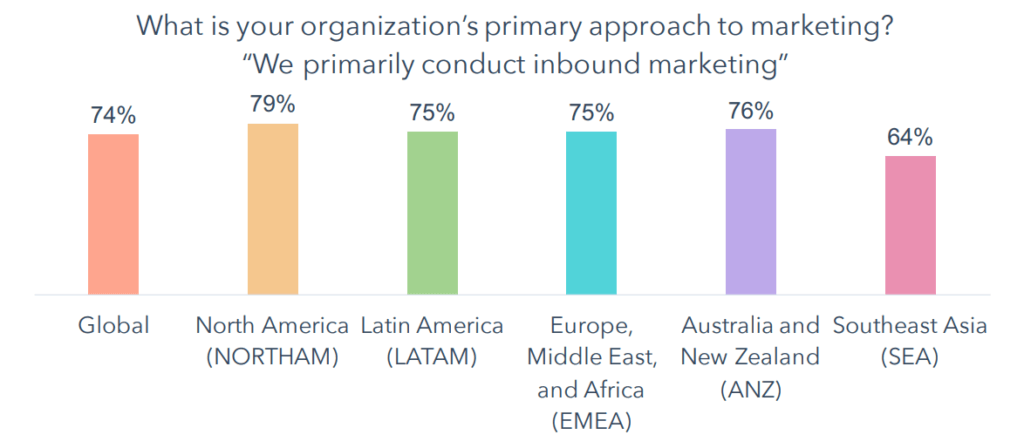
Inbound marketing is here to stay, and not adapting to its growth will cause massive damage to your brand’s success in the long run.
Understanding Loss Aversion
Imagine that I am offering you the opportunity to make $100 in only one hour of work. Pretty sweet deal, right?
However, there’s a catch: if you don’t show up at my office by exactly 6:00 AM tomorrow morning, you won’t get in on the deal.
What’s going to go through your mind upon hearing this? Are you feeling anxious? All of a sudden, it’s not about making $100 in one hour of work anymore—it’s more about avoiding the regret of letting a perfect opportunity slip.
This is the loss aversion bias, which is a cognitive bias that makes us more sensitive to losing than winning. People fear a loss twice as much then they welcome a potential gain.
You can leverage this cognitive bias with your sales team to convince them of adopting inbound marketing. Before highlighting all the benefits of inbound with data and proof (which we’ll get to!), your salespeople have to understand what is at stake if they refuse to adapt. This can include a drastic drop in revenue for your company in the future or even their jobs, as not adapting to the current market will it make harder to close and generate leads.
#3. Show Them the Proof
Numbers don’t lie: after they realize what is at stake, there’s no better way to convince your sales team of the importance of inbound marketing than with data.
The best way to do this is to get them to download HubSpot’s State Of Inbound 2018 report. Each year, HubSpot surveys thousands of respondents from all over the world to get an idea on the current state of inbound marketing, operations, and sales strategies. Within the report, they will get all the proof they need that inbound marketing is the future. Feel free to check out our own The Attendee’s Guide to Inbound 2018.
For example, while only 26% of companies reported their sales and marketing teams to be closely aligned, 85% of those closely aligned companies felt their marketing strategy was effective.
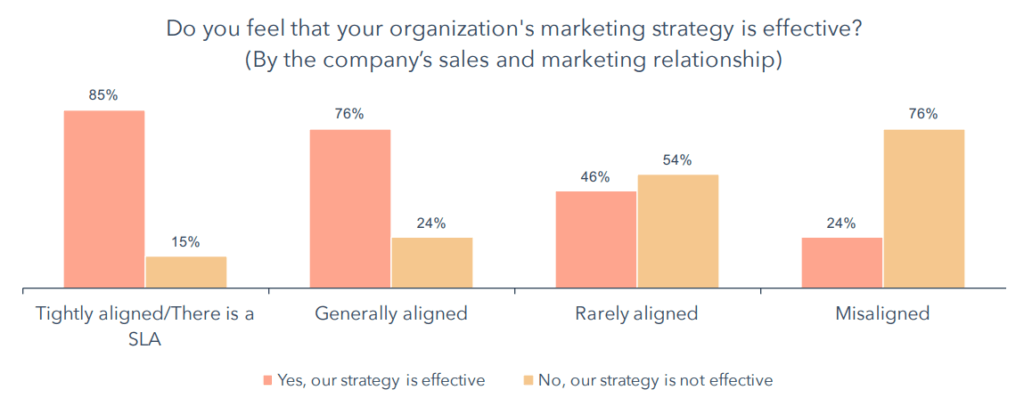
Sales teams from tightly aligned organizations also credit marketing for generating the majority of their quality leads, while those at poorly aligned organizations claim marketing brings in the least.
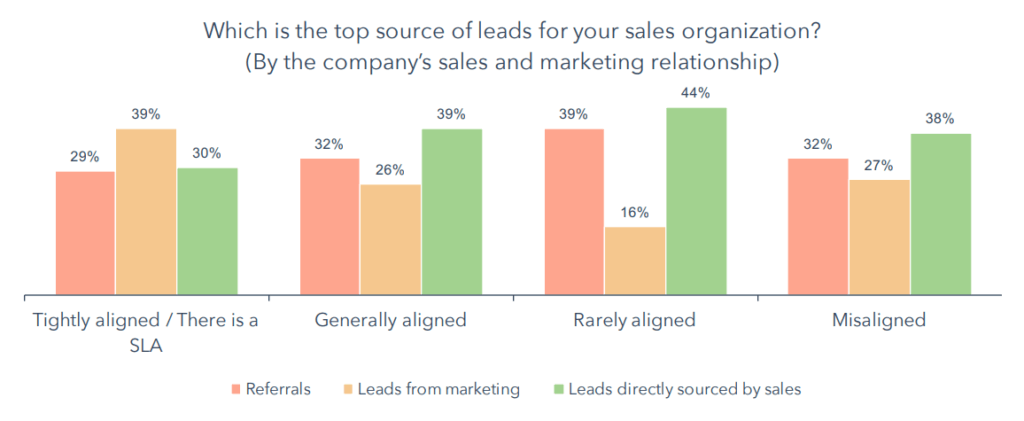
Tightly aligned sales teams also report a higher ROI from inbound marketing than misaligned teams.
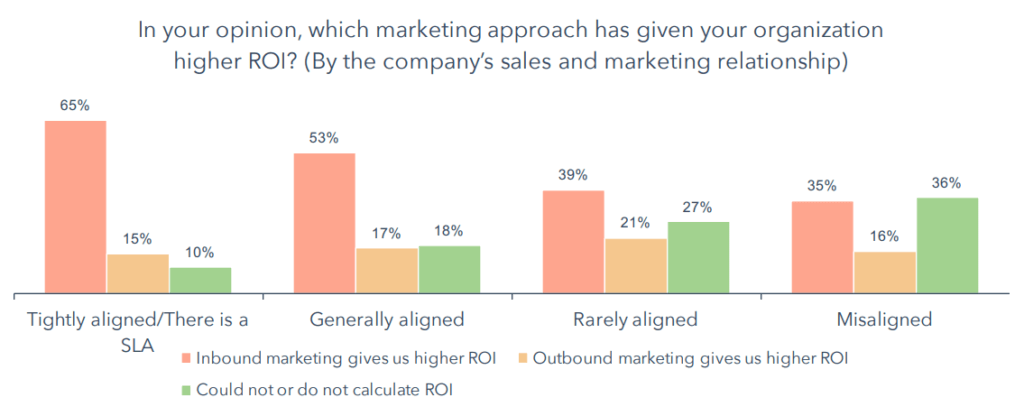
#4. Be Prepared To Dispel Common Objections, Myths, And Misconceptions
You’ve now demonstrated the benefits and necessity of inbound marketing in today’s digital marketplace. However, get yourself ready for potential objections that may come from your salespeople.
Here are the most common objections we hear about inbound marketing:
“Sales and marketing don’t work well together.”
If your sales and marketing teams don’t mix, try creating a smarketing team to align them.
Smarketing involves the closed-loop alignment of both sales and marketing departments in a company. The objective of smarketing is to align both departments with the same organizational goals and to generate higher revenue. Here are the advantages it provides:
- A better understanding of your target audience: Sales and marketing have different understandings of their audience. By combining their customer insights together, your teams will be able to deepen their knowledge of their target audience, finding innovative ways to reach them.
- Growth in revenue: Sales and marketing teams that collaborate enjoy higher revenue for their company as a result. According to SiriusDecisions, organizations that focus on sales and marketing alignment efforts see an average of 19% faster revenue growth and 15% higher profitability.
- Sales and marketing alignment: There has long been tension between sales and marketing departments. When both departments decide to set aside their differences and partner up, the office climate will improve. Not only will a happy environment boost productivity in the office, but it will also attract new talent to join your company.
“You can’t measure the ROI of inbound marketing.”
Thanks to free online tools such asSocial Media Today Google Analytics, Cyfe, and Addvocate, measuring your inbound marketing efforts has never been easier. You can determine how many visitors on your webpage converted into paying customers, how many attendees joined your webinar, and even how many people clicked on a particular link in your email.
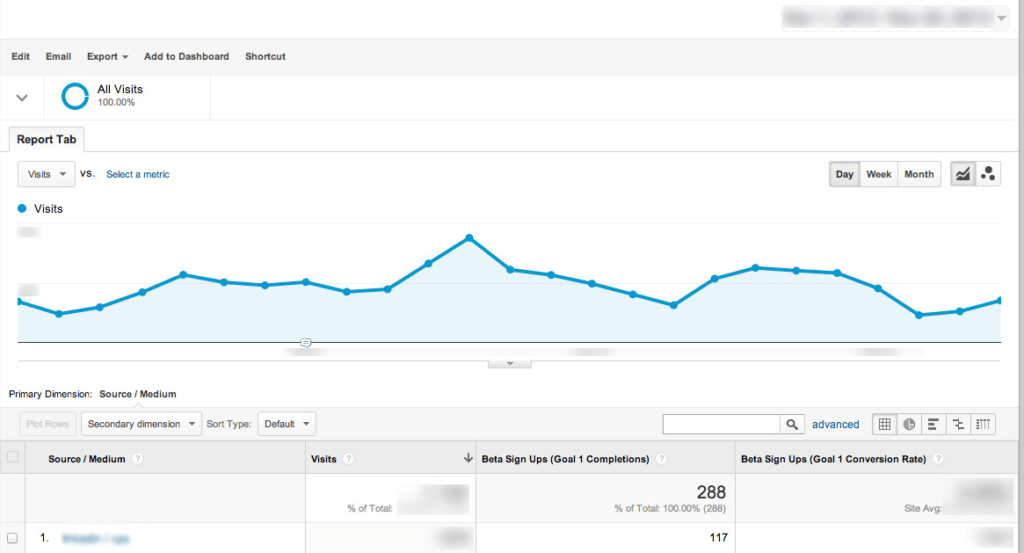
“Inbound marketing takes too much time…”
We’re not going to lie to you.
Inbound marketing is a time-consuming discipline, but anything that will create long-term benefits is going to require time and energy. At the end of the day, what truly matters is the ROI you generate for your company and employees.
If you are too busy or feel like you’re in over your head, then you should consider hiring an inbound marketing team to help accelerate your results. An agency specializing in inbound marketing will create a custom strategy for your business and establish performance indicators to let you if you’re progressing towards your goals.
Wrapping Things Up
Getting your sales team to embrace inbound doesn’t have to be complicated—with the right mindset and tactics, the transition can be done effortlessly in no time.
Are you ready to learn more about inbound marketing? Do you need help aligning your marketing and sales team to create a killer marketing strategy? We can help. Reach out to us; our inbound marketing and strategy experts are ready to help you transform your marketing efforts.




